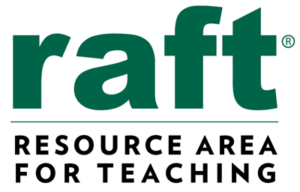Orchard Students Turn RAFT Materials into Safer Wind Turbines for Birds
Ten third graders and twelve fourth graders in Kathleen Gould’s class at Orchard School District know to turn to RAFT when making creative design solutions! They’ve been on a 17-day Design Challenge journey studying how wind turbines kill hundreds of thousands of birds each year in North America—making turbines the most menacing form of green energy!
 Using cardboard tubes, paper pinwheel blades, clay, tape, stickers, cotton balls, bubble wrap, and other RAFT materials, student teams were able to think about and design clever models of wind turbines that might be safer for birds to fly around or nest upon!
Using cardboard tubes, paper pinwheel blades, clay, tape, stickers, cotton balls, bubble wrap, and other RAFT materials, student teams were able to think about and design clever models of wind turbines that might be safer for birds to fly around or nest upon! It started when representatives from the WildLIFE Associates brought into the class rehabilitated falcons, owls, eagles, and other birds damaged by wind turbines. “We learned about Luna the owl, who is now blind in one eye, and Liberty, the bald eagle, who broke its wing from flying into a turbine,” says Gould. Seeing these beautiful wild creatures up close helped the students to empathize with the real-world problem of how to protect birds flying around wind turbines.
“The kids really loved this Design Challenge!” adds Gould. “They researched the history of windmills as sources of energy. They learned about food chains with a fun card game. They studied different bird habitats within California and where wind turbines are located in the state. They had to think about how we impact bird lives.”
Once the students defined the problem, they did the research. They looked at maps of flight patterns and at human habitats that encroach on bird habitats and flight paths. They researched how electromagnetic energy is produced from wind power with hand-crank generators and then compared this to wind turbines. And they made and remade models!
“They loved designing models! They were super excited to experiment with the RAFT materials, learning what did and did not work by testing the strength and weaknesses of different pinwheel blade designs. They had to improve their designs over and over until they created what they thought was the perfect solution for a safer wind turbine!”
Student teams presented their final designs in front of a captive audience of parents and teachers. Several designs included cotton balls attached to a turbine pole and base—“the cotton balls are soft and they won’t hurt the birds that much if they bump into them.”
Another team made a huge net surrounding the turbine to distract the birds from the turbine blades, and said they’d recommend placing the turbines far away from where birds like to live. Other suggestions included coloring the turbines bright colors and putting flashing lights on them so the birds can see them better.
“This was such a highly successful Design Challenge!” comments Gould. “RAFT materials really helped the students understand the problem by using hands-on modeling to find new ways to protect the birds while still living with green energy technology!”
Written by Jeanne Lazzarini, RAFT Master Educator


